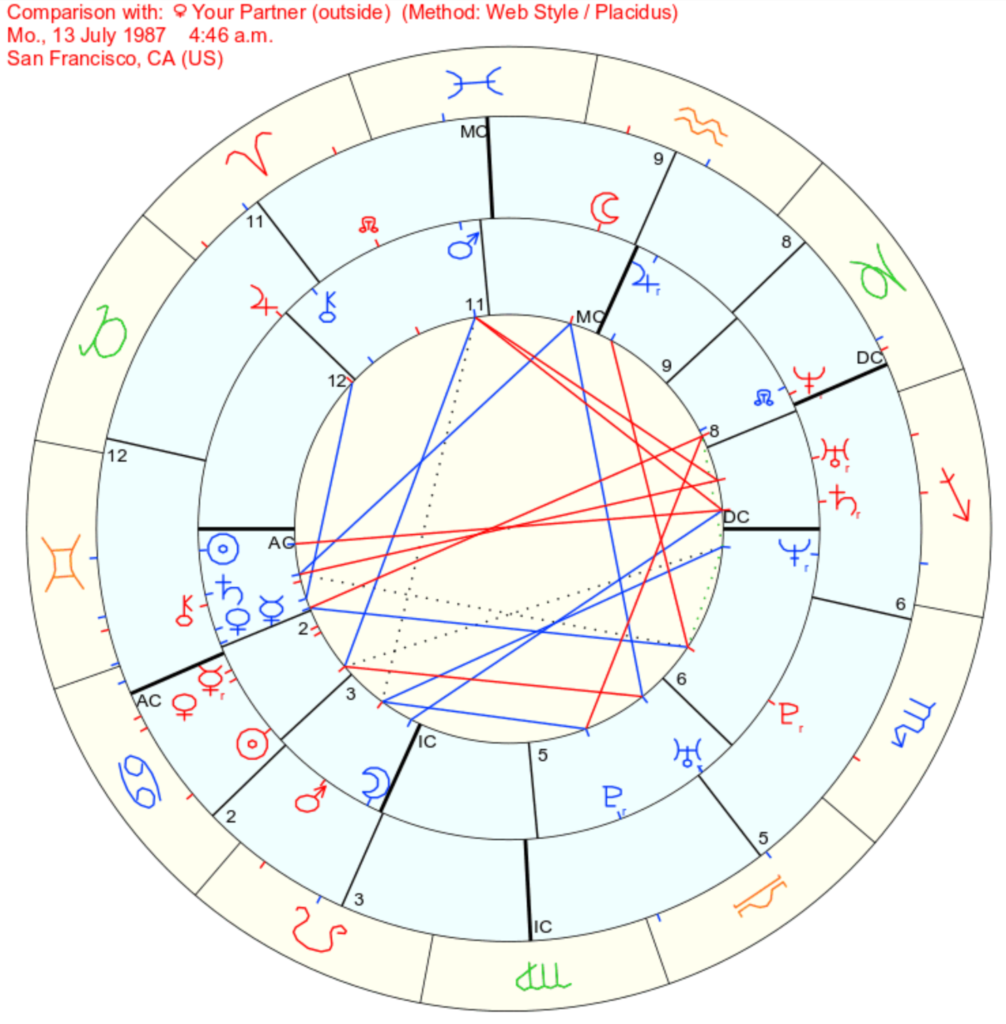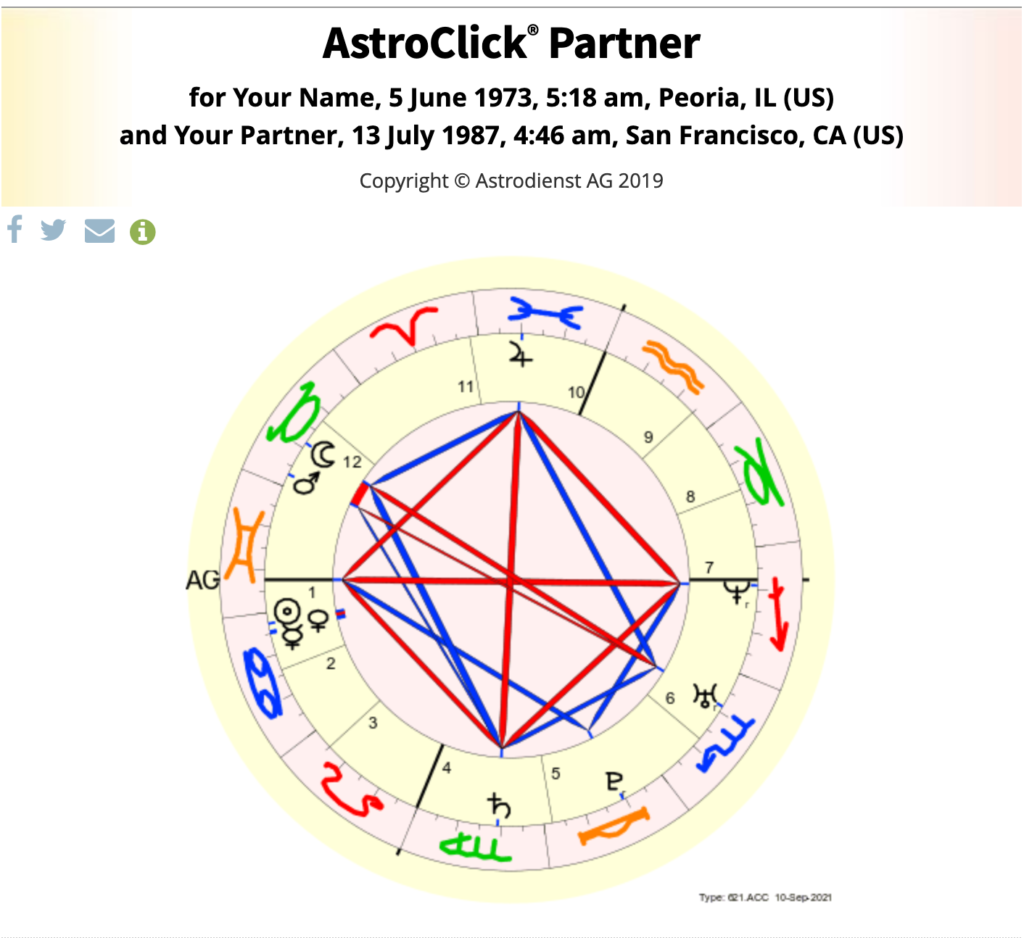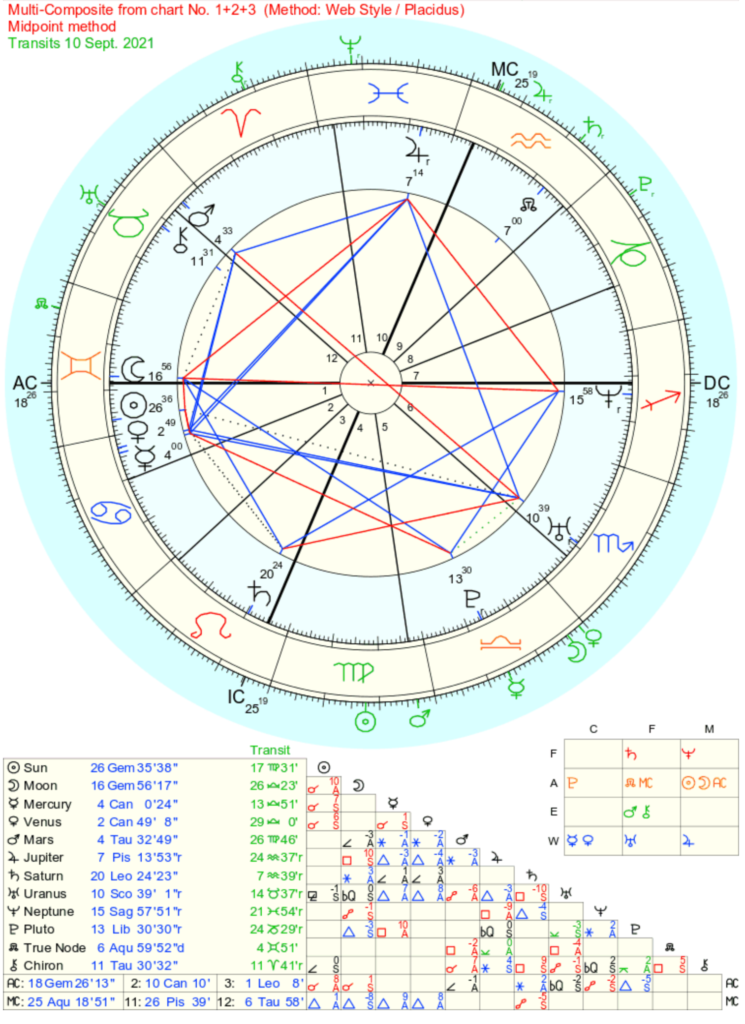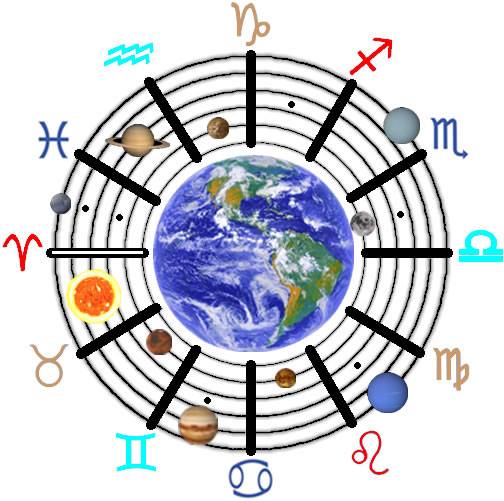In DIY Astrology Part 1, we covered the Natal chart. In DIY Astrology Part 2, we covered Transits. In this entry, we’ll cover relationships and compatibility.
When astrologers are feeling unpopular, two words will garner the attention we crave. Here’s my attempt to wake up those dozing off in the back row; wait for it… “Love” and “Money.” “Love” or “Money” or “Love money” or even “Money love.” If anyone knows of any other possible combination of these two words, please contact me immediately. Many people come to Astrology’s front door seeking love and money, but for those who go inside and make a home, there’s so much more to discover. These topics are like old standards, classic songs we all cover to please the crowd. So, allow me to do my rendition of a little ditty called “Love.“
uh one, two, three, four…
We cannot choose our family members, but we must learn to get along with them. We cannot choose who we’re attracted to or who is attracted to us. We cannot choose our friends or enemies, and sometimes we can’t even tell them apart. Compatibility is complicated and mysterious. Astrology gives a practical navigational tool to guide us through our many relationships. We can learn a great deal about our personal drives from our Natal charts, and we can explore the terrain of our love life in our Transits. We can also view the charts of our friends, family, and lovers to gain insight into their perspectives. But the two main methods for relationship readings are the Synastry chart and the Composite chart.
Natal Charts
First, let’s look at the elements in our Natal chart that can tell us about our love life. Venus is the star of the romance world, and you’ll find her somewhere in every Natal chart. Venus near the Sun or the Ascendant can give one a potent attractive quality to others. Venus in the 7th house can make relationships a focal point throughout one’s life, a love story of sorts. If Venus is our starlet, Mars is the leading man. Look how these planets interact in a Natal chart to learn how we

get along with the opposite sex. And when reading the chart of a potential mate, we can simply put on our Love Goggles. Like the Fortune Cookie game, we just add the words “…in bed” at the end of every sentence.
Venus Transits
When we’re alone, it can seem like we’ll be alone forever. When we’re in a relationship, we may hope that it never ends. There may be no map or compass to the venal terrain, but there is a calendar that can help guide us through the good times and the bad. As Venus moves around the zodiac, she makes every possible aspect to the other planets and angles in our charts. When Venus transits another planet, it’s always a pleasant experience. But we can expect conjunctions and trines to bring us notable highs, especially between Venus and Natal Venus, Mars, and Jupiter. However, when Saturn, Uranus, or Pluto are conjunct, square, or opposing our Natal Venus, we can expect a difficult period in our love life that may last months or years.
Synastry Charts

Once we’ve viewed our Natal chart with our love goggles on, we can do the same with our partner’s Natal chart. We learn a great deal about ourselves and others as individuals from our Natal charts. In a Synastry chart, we learn about our relationships and how we interact with one another. By placing one Natal chart wheel inside of another, we can easily compare the two. It’s a bit like reading one chart with two of every planet, making it possible to have Venus trine Venus, for example. In synastry charts, each chart has its own Ascendant and house placements. The chart on the inside will determine the Ascendant, houses, and angles. Once you’ve viewed one chart as the inner circle, switch them to see how the dynamics change.
AstroDienst
If you haven’t already entered your birth information into the AstroDienst website, you can follow the instructions here.
Calculating a Synastry Chart
From the AstroDienst Homepage, Click on “Horoscopes“
Under “Drawings, Calculations, Data,” Click on “Extended Chart Selection“
Under “Sections“> “Chart type:” in the drop-down menu, select “Synastry Chart (2)“
Under “Birth Data“> “Horoscope for:” in the drop-down menu, select yourself.
Under “Partner:” in the drop-down menu, select your partner.
Click the Blue Button that reads: “Click Here to show chart.”
After viewing the chart, you can go back to the previous page and switch the order of the charts so that your partner becomes the inner circle. The aspects between planets will not change, but they may fall in different houses. Any changes in the house placements represent how each partner perceives the relationship from their unique perspective. There are two sides to every love story, and it’s essential to see both. For each partner to be understood, they must be willing to see both sides equally. The synastry chart allows us to do this as easily as flipping a switch. Well, almost as easily. It helps to come to the table with an open heart and an open mind.
Composite Charts
Relationships are all about chemistry. Something happens to us when we’re in good company. Some people just bring out the best in us. As we look back at the companions we’ve had in our lives, we can see that we’re a different person with each of them. Like a chemical process, we change those around us simply by being there. And they change us, for better or for worse. The composite chart acknowledges this chemical process by fusing two charts into one. Between two entities is a third composite entity. Some people bring out the best in us; some bring out

the worst, like mixing bleach and ammonia in a toxic cocktail. We read a composite chart the way we would read a Natal chart, but for this hypothetical third entity.
We can view a composite chart in the Extended Chart Section, but we’ll need to know how to read a chart. AstroDienst also provides an interactive Composite Chart based on the AstroClick Portrait from DIY Astrology Part 1. Changing the order of charts will not change the results of a composite chart.
Calculating a Composite Chart
From the AstroDienst Homepage, Click on “Horoscopes“
Under “Relationship & Love” Click on “AstroClick Partner“
Under “Horoscope for:” in the drop-down menu, select yourself.
Under “Partner:” in the drop-down menu, select your partner.
Click the Blue Button that reads: “Go.”
Group Charts

We can also cast Composite charts for three or more individuals. The more people we add to the mix, the more the chemistry changes. But in the end, with any group of individuals, there is a complex composite character. When we add someone, or when someone is not present, we cannot help but notice how it changes the group’s nature. While each member maintains their individual character represented in their Natal Charts, the Composite
Chart reveals the group’s character as a whole. AstroDienst can calculate Multi-Composite charts of 3 or more but does not provide an interactive version with aspect interpretations.
Calculating a Multi-Composite Chart
From the AstroDienst Homepage, Click on “Horoscopes“
Under “Drawings, Calculations, Data,” Click on “Extended Chart Selection“
Under “Sections“> “Chart type:” select “Multi-Composite, midpoint method“
Under “Birth Data“> “Horoscope for:” select yourself.
Under “Partner:” select another member of your group.
Click the Blue Button that reads: “Click Here to show chart.”
Once the initial chart appears, change the number of persons in the Birth Data area at the top of the page and hit “Enter/Return” on your keyboard. When you have all of the birth data entered, click any of the “Go” buttons to display your Multi-Composite chart. It will take some experience to read this chart, and several books and online resources can help you. But just like any composite chart, it represents a single hypothetical entity. Therefore, we read a group chart as if for an individual with one of each planet. It’s also possible to do synastry charts for three or more individuals, but AstroDienst only allows for 2.

Depending on the nature of our group, we may look for different configurations in a Composite chart. A new start-up company will be looking for capital (Jupiter) and the discipline to spend it wisely (Saturn). A new band will need some inspiration (Neptune) and good management (Mercury/Saturn). A traditional family will need a large home (Jupiter in the 4th house) and at least one steady income (Saturn in the 10th house). These are just examples, of course. Many creative configurations may lead to a successful group. There are pros and cons to each possible placement, and we have a great deal of free will in how we handle our given circumstances.
Group Transits
With the click of a button, we can add the current planetary positions to any Composite chart to view our group’s transits. Simply click on the blue button that reads: “+ With Transits,” and the transiting planets will appear in green on the outside of the chart circle. If we want to see transits from the past or future, we can go back to the chart selection page and change the date under “Start Date.” We read transits to our Composite chart the same way we do with our Natal charts, but for the hypothetical group entity. We may not have ideal aspects in our composite chart, but transiting planets will provide similar opportunities for a limited time only. This is why it’s so important to be prepared for those moments before they slip away.

Relationships are mysterious, and mysteries are meant to be solved. We often wonder what makes other people tick, but we don’t expect to find out in excruciating detail. Not only do we find the answers to our questions when we view our synastry and composite charts, we find more than we were looking for. Sometimes we just want a quick soundbite, but we get a 60,000-word manuscript to thumb through. AstroDienst makes it easy to access important information, almost too easy, and often TMI. As with your Natal Chart and Transits, I recommend you make the most of AstroDienst. But I also recommend that you get a reading from a professional astrologer to help put it all into perspective. Click Here to schedule a session.

